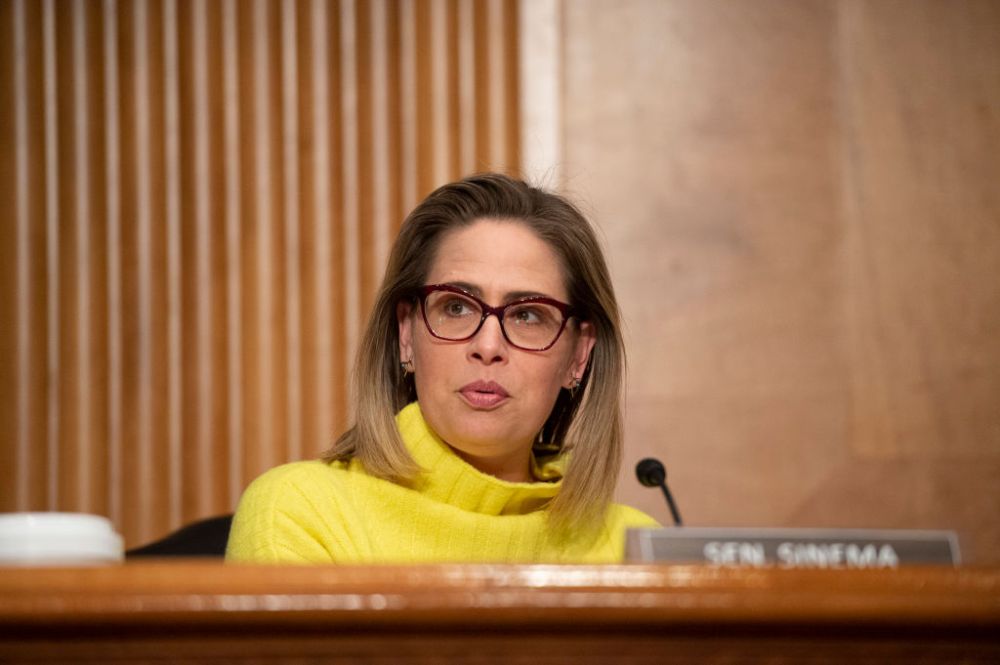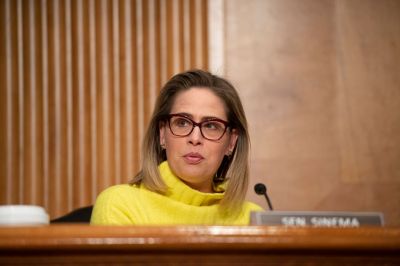It’s always perilous trying to parse the motives of politicians who seem recognizably human.
Thankfully, there aren’t many.
Politicians are predictable, humans are complex. If you want to know what Ted Cruz will do in any given situation, simply ask yourself, “Which course of action would bring him one iota closer to becoming president?” You’ll anticipate his moves with well above 99 percent accuracy.
Being recognizably human, Kyrsten Sinema is a harder nut to crack. She’s younger than most of her colleagues. She’s more colorful, stylistically and otherwise. She has honest-to-God interests outside of politics. And she gets along with members of the other party, a common enough trait among human beings but one increasingly rare among those who make their living in government.
As of this morning, she’s officially an independent.
In our loathsome political era, casting off one’s partisan affiliation is exactly what a normal human being would do, and what many have done. But it’s a strange move for an incumbent officeholder even by the inscrutable standards of the Sphinx of the Senate.
What is she up to?
When Sinema joined the chamber in 2019, her path to reelection was easy to plot. Someone who came up in politics as a member of the Green Party could be counted on not to cross her base except with occasional panders to swing voters on Arizona-specific issues like securing the border. Dependable partisan liberalism seasoned with a sprinkle of centrism was a formula for success in a state that’s been drifting left. Ask Mark Kelly.
Sinema didn’t follow that path. Somewhere along the way, she morphed from Green Party stalwart to champion of the carried-interest deduction. She tweaked the left by delivering a glib thumbs-down when the Senate voted on raising the minimum wage, then infuriated them by refusing to end the filibuster in the name of passing voting-rights legislation. She fought them for months on Build Back Better before ultimately signing on to a watered-down version. Earlier this year her state party took the extraordinary step of censuring her, a punishment typically inflicted in American politics only for egregious acts like opposing coup attempts.
Democrats expected Joe Manchin to drive a hard bargain in negotiations, seeing as how he’s a centrist representing a Trump +40 state. They did not expect a young progressive from a state Joe Biden won to join him in doing so.
In fairness, Sinema’s odd trajectory and sudden declaration of independence aren’t totally out of the blue. She’s sounded maverick-y notes throughout her political career, even before she joined Congress.
For years she’s also skipped the regular caucus lunches at which her colleagues plot strategy. In her victory speech in 2018 she saluted her state’s original maverick, a Republican: “Sen. John McCain stood for everything we stand for as Arizonans: fighting for what you believe in, standing up for what's right even if you stand alone, and serving a cause that's greater than oneself.” More than one Democratic operative told Time magazine last year they believed Sinema views herself as McCain’s political heir, a kindred spirit in her willingness to cross her party.
But McCain never left his party outright. And despite populist antipathy toward him, he never lost an election in Arizona. At last check, Sinema was at dire risk of doing so.
Progressive efforts to organize a primary challenge to her have been in full swing for months despite her seat not being up for two years. One formidable potential rival, Dem Rep. Ruben Gallego, led Sinema by more than 20 points in polling published a year ago. In the fall of 2021, when leftist anger at her over Build Back Better spiked, her approval/disapproval rating among Arizona’s primary voters stood at 25/70.
She might do better in 2024 as a Republican, frankly.
And when news first broke Friday morning that she was leaving the Democratic Party, it seemed like that might be the plan. Had Sinema announced that she would caucus with Republicans going forward, it would have moved the Senate from a 51-49 Democratic advantage back to the 50/50 stalemate of the past two years. That in turn would have forced Chuck Schumer to agree to share power with Republicans in Senate committees, slowing down confirmations and legislation, and would have restored Manchin’s veto over Democratic bills. Sinema would have pulled off an audacious act of lib-owning, instantly boosting her popularity among the American right.
But that’s not happening. While she’s been coy about whether she’ll caucus with Democrats, she explicitly ruled out caucusing with McConnell and the GOP. (She’ll keep her current committee assignments, Schumer announced this morning.) At worst, Democrats will retain a 50-49-1 advantage in the Senate, allowing the party to dominate committees. At best, Sinema will continue to caucus with them and slide into the niche occupied by Bernie Sanders and Angus King of being a nominal independent who’s otherwise indistinguishable from a partisan Dem.
Or, as one Twitter pal put it, “Major news: we've renamed an existing situation.”
Plus, let’s face it. Even if Sinema owned the libs by agreeing to caucus with the GOP, it almost certainly wouldn’t help her win reelection in Arizona as a Republican. This Hugh Hewitt tweet made me laugh:
I’m keen to hear Hugh’s theory of how a pro-choice, pro-gay liberal who twice voted to convict Trump would be the choice of a conservative primary electorate that just nominated Kari Lake and Mark Finchem.
One way to tell that her announcement isn’t designed to be a thumb in the eye of Democrats is the timing. If Sinema had wanted to screw her former party, she would have gone indie before the Georgia Senate runoff and given ambivalent Republican voters there a strong reason to turn out for Herschel Walker. Another way to tell is to read her op-ed explaining her decision, which is long on “branding” but very short on policy differences with the left. This isn’t a liberal having a conservative awakening, it’s a liberal reiterating that she believes what she believes while repositioning as nonpartisan and above the fray.
In case it wasn’t clear enough, she made it crystal for Politico: “Nothing will change about my values or my behavior.”
Sinema going indie isn’t totally meaningless for how the Senate operates. For instance, if a Democratic senator were to die or miss many months because of illness, a 49-49-1 chamber would be … interesting. But it’s mostly meaningless. So why would she bother with a rebranding at all?
How you answer depends on how charitable to her you wish to be.
The most charitable theory is that Sinema takes her bipartisanship seriously enough that she’s willing to set an example for other centrists in the Senate by casting party affiliation aside. This could be her attempt to jumpstart an “independent caucus” that would wield massive power over legislation in a closely divided chamber. First Sinema breaks with the Dems; then Mitt Romney breaks with Republicans; then Manchin dumps Team Blue; then Susan Collins and Lisa Murkowski dump Team Red. The dam breaks. The nucleus of a real-life third party is formed.
Whichever major party ended up with control of the Senate when the dust settled, they’d need the backing of the new Unaffiliated Caucus to advance anything. Sinema and the other moderates would call the tune.
It’s hard to imagine a politician risking her career to build a centrist independent alternative to the left and right. But it’s not that hard to imagine a human being doing so.
The wrinkle in that theory, though, is that the centrists can caucus together right now if they like without ditching their party affiliation, in which case what do they gain by ditching it? Having roughly half your state behind you on pure partisan grounds makes reelection much easier than trying to win a three-way race as an independent against the two major parties. Joe Manchin’s only chance at reelection in 2024 is to have West Virginia’s Democrats behind him in lockstep while peeling off a few Republicans, the same formula that worked for him in 2018. Why would he needlessly antagonize those Democrats by declaring independence?
If the idea is that by doing so he would boost his appeal to Republicans, he could do that much more effectively by switching parties altogether.
A less charitable theory to explain Sinema’s rebranding is that she’s planning to run for president. The next cycle presents an unusually plum opportunity for a third-party candidate since it’s likely to pit a senescent 82-year-old against a 78-year-old with half a dozen personality disorders. Disenchanted voters might take a shine to a fortysomething female senator with a track record of policy success in her first term that even seasoned legislators would envy. Infrastructure, gun control, gay marriage, and now (maybe) immigration reform: Sinema is in the thick of every major bipartisan achievement of the current Congress.
Poll Americans on whether they want their representatives to compromise on policy or to hold out on their partisan demands and you’ll find “compromise” winning nearly every time. That’s Sinema all over. She could run in 2024 as the can-do alternative to an enfeebled president and an authoritarian lunatic. As of this morning, she’s the most prominent centrist independent in the United States.
But … why would she want to run? She wouldn’t win. In the end most disillusioned voters will stick with the two major parties for strategic reasons, because they fear that wasting a vote on a longshot will pave the way to victory for the other side. Sinema would be relegated to a minor protest candidacy, one likely to hand Trump the presidency by drawing some anti-Trump centrist swing voters away from Biden.
For what it’s worth, she insists that’s not her angle. “I am not running for president,” she told Politico during an interview about her new independence.
Which brings us to the least charitable theory.
For all her apparent humanity, Sinema is still a politician. She does what she needs to do to protect her own electoral viability. Which, in the unique circumstances she’s created for herself, means cynically declaring herself unaffiliated while not changing her policy preferences in the slightest.
Sinema is “playing chicken” with Democrats, in Jonathan Chait’s words.
If she runs in a Democratic primary against Gallego, she’ll get obliterated. (And make no mistake, he’s interested.) If she switches parties and runs as a Republican, she’ll get obliterated. Her least bad choice is to run as an independent—but not because she expects to win a three-way race. By going indie she’s hoping to avoid a three-way race altogether.
Sinema is gambling that if Arizona Democrats are forced to choose between reluctantly supporting her as an independent or nominating Gallego and risking a three-way race that ends up sending, say, Kari Lake to the Senate, they’ll grit their teeth and stick with her. She’s calling their bluff, threatening to all but hand the seat to a MAGA crank if Democrats back home insist on running their own candidate.
The hard turn toward crankishness taken by the Arizona GOP over the last five years is an asset to Sinema here since it raises the stakes for Democrats of splitting their votes between her and Gallego in 2024. Lake might not be able to beat Sinema or Gallego head to head, but it’s easy to imagine her winning with a 47 percent plurality while the 53 percent majority divides between two liberals.
The “chicken” theory of her announcement makes the most sense of the three I’ve considered, but this one also has a flaw. Her behavior over the past 18 months is difficult to explain if she’s so hellbent on reelection that she’d play this degree of hardball with her (former) party to try to save her seat.
If Sinema is desperate for another term, why didn’t she cooperate more with Schumer and her caucus on legislation? Had she supported Build Back Better while standing firm for the filibuster, or supported ending the filibuster while opposing Build Back Better, her base would have been miffed but would have forgiven her over time in the interest of retaining her seat, I think.
Instead Sinema antagonized them on both counts, turning them into enemies. And now, rather than find ways to reconcile, she’s kissing them off altogether by leaving the party and daring Democrats to nominate someone else in 2024. Which is destined to antagonize them further.
Assuming it hasn’t already, eventually that antagonism will turn vindictive and Arizona Democrats will decide they’d rather risk Kari Lake winning than let an arrogant, disdainful incumbent skate to reelection because they were too afraid to challenge her in a three-way race.
And if I’m right that they’ll insist on nominating Gallego or some alternative, odds are good that Sinema will land in third place in early polling of the three-way race. She’ll pick up some support from the center-left and center-right but Gallego will lock down most Democrats while the GOP nominee locks down most Republicans. (Nearly all Republicans, perhaps, if that nominee turns out to be Doug Ducey.) If it’s Lake 45, Gallego 40, Sinema 15, one of those three will face intense pressure to drop out and create a binary choice for Arizona voters.
And it won’t be Ruben Gallego.
When Joe Lieberman won reelection to the Senate in 2006 after losing the Democratic primary, he managed to do so only because Republicans all but abandoned their own nominee in order to support Lieberman. (Much to the annoyance of a left-wing activist named Kyrsten Sinema, by the way.) That won’t happen in Arizona. The Republican base is too far right and Sinema too far left for there to be a massive crossover vote aimed at defeating Gallego.
If she intends to win, she’ll have to find the votes elsewhere. Where?
Sinema’s best shot at reelection was obvious, I thought. With the House now under GOP control, she was free to tack hard to the left over the next two years to try to reingratiate herself to Arizona Democrats. If she became a staunch advocate for single-payer health care or an outspoken proponent of codifying Roe v. Wade or even a very belated convert to eliminating the filibuster, that could move liberal sentiment back toward her.
Probably not much, granted. Many Democrats would find it too convenient that she decided the filibuster was worth dumping only at the very moment that it became impossible for progressive legislation to pass the House. But a little contrition would go a long way. Incumbents aren’t lightly tossed out in primaries, especially in closely run swing states.
The fact that Sinema chose to become more rather than less antagonistic to her party by leaving it is mystifying, and leads me to suspect she won’t run for reelection in the end. In her own way, she may be following Liz Cheney’s path: Having already rendered herself unelectable in a primary by resolving to do what she thought was right, she has nothing left to lose. She might as well keep doing what she thinks is right and let the electoral chips fall where they may. In the end, losing by 10 points or by 40 points is academic.
She’s a maverick. Last year she was a little too maverick-y for her own electoral good, so now she’s going Full Metal Maverick. There are worse legacies to have.







Please note that we at The Dispatch hold ourselves, our work, and our commenters to a higher standard than other places on the internet. We welcome comments that foster genuine debate or discussion—including comments critical of us or our work—but responses that include ad hominem attacks on fellow Dispatch members or are intended to stoke fear and anger may be moderated.
With your membership, you only have the ability to comment on The Morning Dispatch articles. Consider upgrading to join the conversation everywhere.